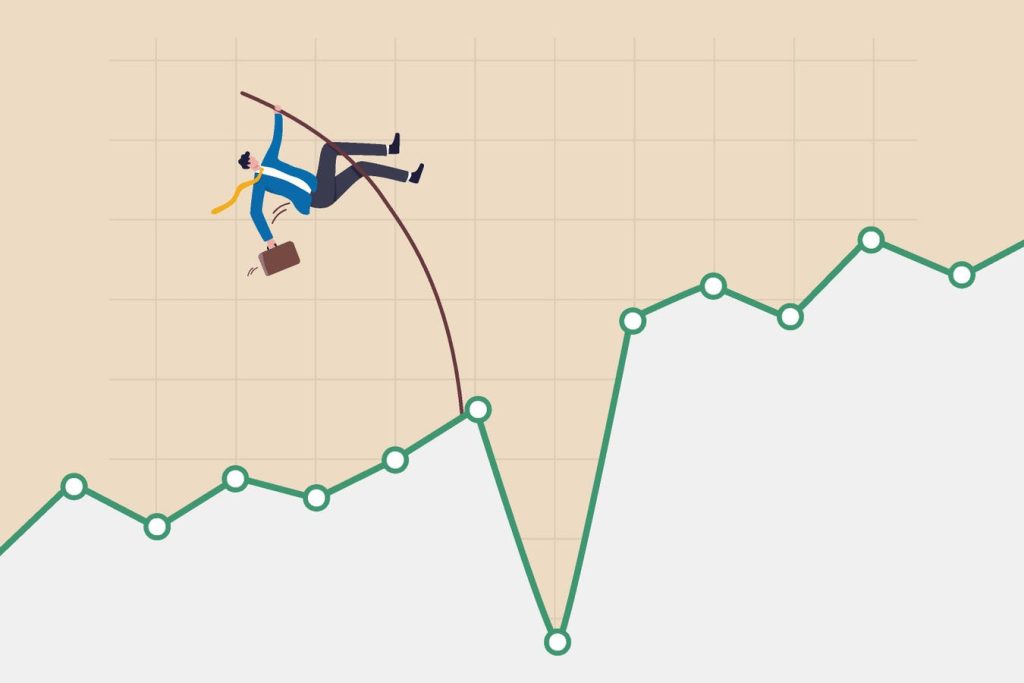If you have a large amount of excess cash to invest, consider dollar-cost averaging as it helps … More
If you have a large amount of excess cash to invest, you may wonder if it’s better to invest over time by dollar-cost averaging or put a lump sum into the market at once. Whether you have extra cash sitting on the sidelines or are second-guessing your investment strategy, it’s easy to let hindsight bias or a fear of losing money impact your decisions. Especially during periods of heightened uncertainty, dollar-cost averaging a large sum can be an effective way to reduce risk and avoid temptation to try and time the market or predict short term volatility.
How Dollar-Cost Averaging Works
Dollar-cost averaging is an investment strategy that invests a set amount of money over a period of time as illustrated by the example below. If markets decline, investors can buy more shares with the same investment amount, and thus benefit more from an eventual recovery. Of course, in rising markets, the opposite is true.
How dollar-cost averaging can help investors during volatile markets.
By making a continuous investment at predetermined intervals, perhaps the first trading day of the month, it takes the decision making out of it and helps minimize volatility as contributions are spread over time. As market conditions change, for better or worse, you’ll continue investing.
Dollar-Cost Averaging in Volatile Markets
The example below compares two scenarios: a lump sum investment of $120,000 in January 2020 compared to a dollar-cost average strategy with $10,000 invested each month from January through December 2020. Both scenarios assume all funds are invested in the S&P 500 (SPY). Since 2020 was one of the most volatile years in the history of the financial markets, it’s a good example.
Comparing a hypothetical lump sum investment of $120,000 in the S&P 500 on January 2020 vs a … More
As you can see, by the end of the year, the dollar-cost averaging strategy marginally outperforms investing a lump sum immediately. Over time, since historically markets have been positive in magnitude and frequency more often than negative, we would expect lump sum investing to outperform.
Is Dollar-Cost Averaging During Market Volatility Better than Investing a Lump Sum?
Despite a long-term view that shows growth potential over a typical investment horizon, it’s so important not to discount the impact of investor psychology during downturns.
Using the example above, by March 23rd 2020 (the bottom for the calendar year), the lump sum investor’s portfolio would be worth less than $84,000, marking an unrealized loss of about $36,000 from their initial investment.
In contrast, the dollar-cost averaging investor’s account would be just shy of $22,000, for an unrealized loss of roughly $8,000.
Here, the lump sum investor may be more prone to panic selling during declining markets and going back to cash. If they did, and if the other account continued putting money in the market at regular intervals, the gap at the end of the year would be significant. Investing over time can be particularly impactful for individuals experiencing a one-time sudden wealth or liquidity event.
Of course, in practice, investors will want to match their risk tolerance with a diversified portfolio.
Avoid Market Timing And Stick With the Plan
The reality is that many investors don’t like to invest more when the market is down. The stock market is the only place where people run from a sale. In hindsight, after the market has recovered, investors often regret not taking advantage of what they now know to be a great buying opportunity.
Dollar-cost averaging helps investors avoid the temptation to try to time the market or worse: abandon their investment plan altogether if facing significant losses. It can also help smooth the impact of price volatility and potentially lead to more favorable average prices.
When Is It Better To Invest A Lump Sum?
When it comes to dollar-cost averaging vs lump sum investing, the best approach may ultimately be a personal decision. Due to transaction costs and the cash drag on a portfolio, in situations where there’s a smaller investment amount, it might be more advantageous to go with a lump sum approach. Also consider your target asset allocation and share prices compared to your excess cash.
Time In The Market, Not Timing The Market
The stock market is no place to invest for quick returns. While dollar-cost averaging can help reduce the short-term impact of market fluctuations, avoiding volatility in the financial markets is unrealistic. Instead, investors should stay focused on long-term wealth building strategies and making sure their asset allocation is right given their life stage and risk tolerance.
Time in the market is better than timing the market over the long term, and history shows that the longer you stay invested in the stock market, the better your chances of making money.
So why not put a large sum to work at once?
Investors often downplay the behavioral aspects of investing until faced with a big decision that carries risk. So when the thought of putting all your money in the market at once seems too stressful—don’t! Dollar-cost averaging can help individuals sleep at night. After all, hoarding cash isn’t an investment strategy.
Disclosures
Kristin McKenna is a Forbes contributor. Examples in her articles are generic, hypothetical and for illustration purposes only and should not be misinterpreted as personalized advice of any kind or a recommendation for any specific investment product, financial or tax strategy. This general communication should not be used as the basis for making any type of tax, financial, legal, or investment decision. If you have questions about your personal financial situation, consider speaking with a financial advisor.

